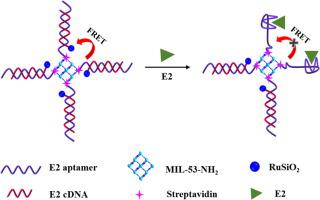Journal of Colloid and Interface Science ( IF 9.4 ) Pub Date : 2020-09-17 , DOI: 10.1016/j.jcis.2020.09.030 Haifeng Sha 1 , Bing Yan 2

|
17β-Estradiol (E2), an important endocrine disrupting compound, could be quantitatively detected by fluorescence resonance energy transfer (FRET) aptasensor, designed in this paper. Metal organic frameworks have large specific surface area and easily modifiable groups, which are helpful for the construction of aptasensor. Specifically, streptavidin was immobilized on the synthesized MIL-53-NH2 by covalent bonding, and further linked with the biotin modified E2 aptamer (apt) through specific bonding between avidin and biotin to obtain the FRET donor probe (MIL-53-apt). Meanwhile, complementary DNA (cDNA) modified Ru(bpy)32+-doped silica nanoparticles (RuSiO2-cDNA) were prepared through covalent bonding. They acted as the FRET acceptor probe, since its absorption spectrum showed large overlap with the emission spectrum of MIL-53-apt. In the presence of E2, aptamer modified donor probes tended to bind with E2, owing to their higher selectivity and affinity. Therefore, the optimal distance between FRET pairs was broken, resulting in the fluorescence emission recovery of donor and the fluorescence emission of acceptor decreased. Under optimal conditions, this proposed aptasensor displayed sensitive detection of E2 ranging from 0.5 to 1000 nM with a detection limit of 0.2 nM. Furthermore, the sensor provides a promising method for rapid and sensitive detection of other small biological molecules.
中文翻译:

基于金属有机骨架和Ru(bpy)3 2+掺杂的二氧化硅复合材料的比例荧光传感器的设计,用于17β-雌二醇检测
本文设计的荧光共振能量转移(FRET)适体传感器可以定量检测重要的内分泌干扰化合物17β-雌二醇(E2)。金属有机骨架具有较大的比表面积和易于修饰的基团,这有助于构建适体传感器。具体而言,将链霉亲和素通过共价键固定在合成的MIL-53-NH 2上,并通过抗生物素蛋白和生物素之间的特异性键合与生物素修饰的E2适体(apt)连接,以获得FRET供体探针(MIL-53-apt) 。同时,互补DNA(cDNA)修饰了Ru(bpy)3 2+掺杂的二氧化硅纳米粒子(RuSiO 2-cDNA)是通过共价键制备的。它们充当FRET受体探针,因为其吸收光谱与MIL-53-apt的发射光谱显示出很大的重叠。在存在E2的情况下,由于适体修饰的供体探针具有较高的选择性和亲和力,因此倾向于与E2结合。因此,FRET对之间的最佳距离被打破,导致供体的荧光发射恢复,受体的荧光发射降低。在最佳条件下,该拟议的适体传感器对E2的检测灵敏度为0.5至1000 nM,检测极限为0.2 nM。此外,该传感器为快速,灵敏地检测其他小生物分子提供了一种有前途的方法。









































 京公网安备 11010802027423号
京公网安备 11010802027423号